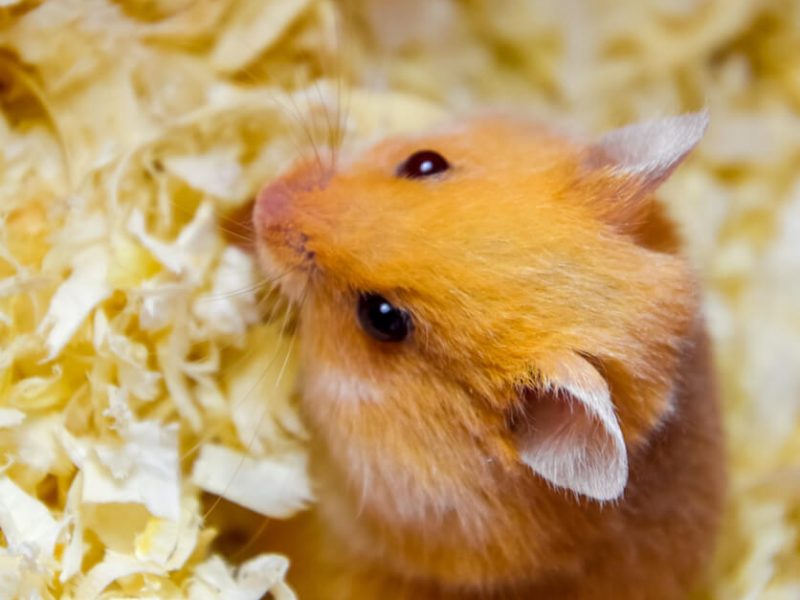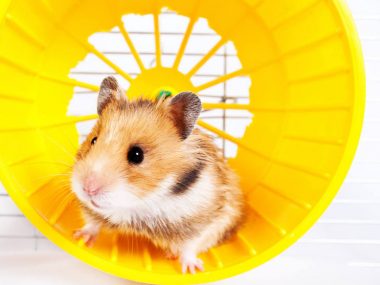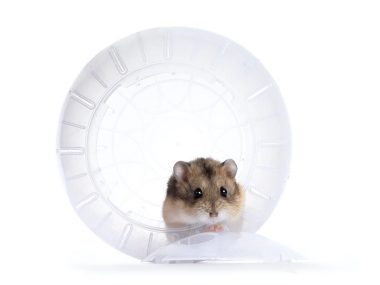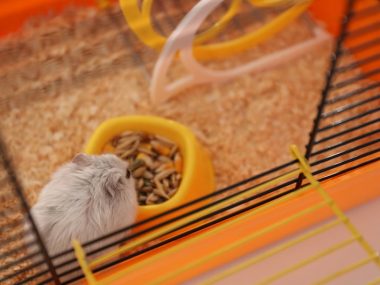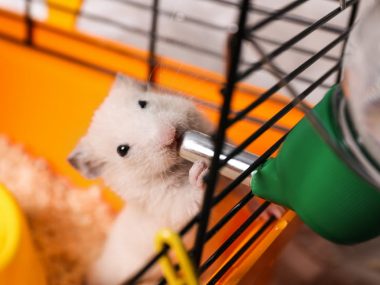Move aside wood shavings. There’s scientific evidence that our hammies prefer fluffy, marshmallow-like options to slumber upon. Come on, you can’t resist finding how researchers come up with new types of hamster bedding!
Table of Contents
What Is Hamster Bedding?
Hamster bedding is what most of us know as the fluffy stuff that sits on the bottom of the cage. It’s in this bedding that the hamster happily tunnels through where it settles in nice comfy area inches below.
Hamster cage bedding is a substrate that functions as a material that satisfies a hamster’s need to burrow and nest. Bedding plays an important role in the absorption of hamster excrement, promoting a more sanitary environment. This bedding is typically made from paper, pellets, wood shavings, or plant-based materials.
One of the leading questions hamster parents ask is, “Do hamsters need deep bedding or bedding altogether?” Placing a paper liner or a nice soft flat towel in the bottom of your hamster’s cage is not recommended. Let’s take a closer look at why they need proper bedding.
Why Do Hamsters Need Bedding?
Hamsters require appropriate bedding that’s made of safe materials and is deep enough to meet its burrowing needs. Their bedding provides a barrier that collects excrement. The bedding also provides enrichment and insulation.
A hamster’s natural instinct is to burrow, tunnel, and nest. In the wild, these little guys create underground tunnel systems complete with burrows where they live and store food. Whether a hamster is domesticated or wild, that instinctive need to burrow and dig is present. Denying them this pleasure within a cage is not only cruel but causes stress and may lead to a very unhappy and possibly sick hamster.
Imagine your hamster in its cage during the winter. Regardless of how we strive to keep our homes heated, there’s the inevitable draft and chill that creeps into the house. When we are cold, we grab a blanket or a jacket to cover up with. Your hamster’s blanket or jacket comes in the form of its bedding. When it gets cold, it burrows beneath the bedding to get warm.
How To Choose The Best Hamster Bedding
When shopping around for hamster bedding, it’s important to get something that’s safe. But how do you know what’s good for your hamster? We have done a bit of research to provide you with evidence-based information to help guide you in making well-informed purchases when it comes to hamster bedding.
Bad Hamster Bedding
You have probably noticed many online pet sources warning against the use of wood shavings such as pine or cedar. The Royal Veterinary College Department of Pathology in London published a research article (Carcinogenicity of Wood Shavings) on the toxicity of pine/cedar wood shavings used as bedding for rodents (which includes hamsters.) The study states aldehydic compounds (which includes coniferaldehyde and sinapaldehyde) may have carcinogenic (cancer-causing) activities for rodents exposed to the wood shavings.
Researchers in another study (The toxicity of constituents of cedar and pine woods to pulmonary epithelium) found that exposure to cedar/pine wood shavings and their resins had the potential to cause respiratory difficulty and lung disease in both humans and rodents.
Hamsters are notorious for chewing and eating bedding. Because of this, what goes in must come out, and unfortunately, some materials used in bedding do not come out, causing issues for the hamster’s digestive system.
Hamster bedding types to avoid include:
- Pine/cedar wood shavings
- Plant-based bedding made from corn cobs
- Non-water-soluble
Good Hamster Bedding
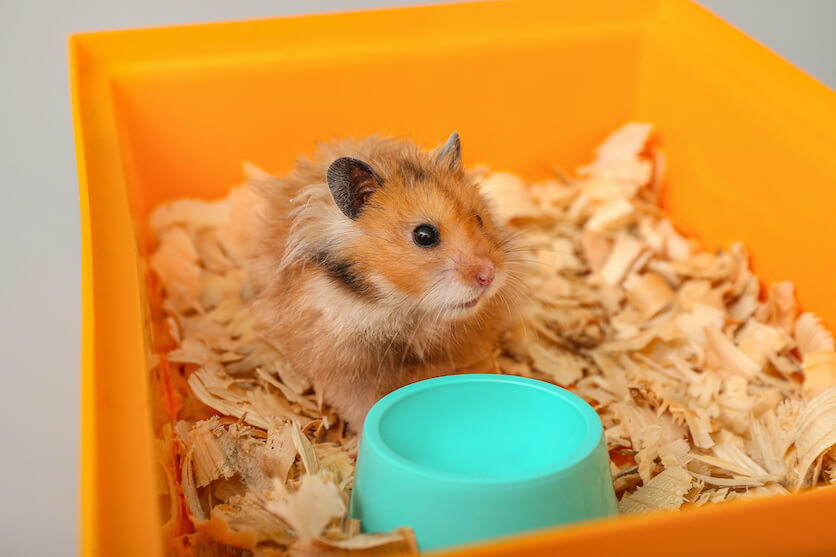
An interesting research study done by Purdue University Veterinary Medicine reported that rodents actually have preferences when it comes to bedding. Rodents (which includes hamsters) prefer fluffier bedding materials they are able to move around in and through without difficulty. Paper-based bedding was better at allowing the rodents to make nests in. Bedding made with small particles was definitely a no-go with the rodents.
The ideal bedding for a hamster should:
- Be absorbent
- Be free from toxins such as resin (found in wood,) chemicals, fragrances, and dust
- Be able to minimize ammonia odor
- Allow hamsters to comfortably move through and maneuver for nesting and burrowing
- Be a minimum of 15 inches deep
- Be water soluble
There’s a widespread dilemma in hamster cages not being deep enough to accommodate the recommended amount of bedding. Most cages provide about 4-8 inches of depth for bedding. You’re probably thinking there’s no way 15 inches of bedding can possibly go into any hamster cage. However, there are cages on the market that are designed for this very reason. Multi-level hamster cages are perfect for this very reason.
A good example is one that has a cage situated on top of a glass aquarium. A ramp extends from the cage down into the aquarium giving the hamster easy access between the two. The cage serves as a place for the wheel, water, food, nesting box, and toys. Below in the aquarium is nothing but bedding. It’s there where your hamster will burrow, nest, and sleep.
So when it comes to certain types of bedding, what is the best bedding for a hamster? Let’s look closer at each type and the advantages and disadvantages of each.
Types Of Hamster Bedding
Now we dive into the information you’ve been waiting for! We have broken down the different types of bedding and laid it out there to help you decide which is best for your hamster.
Homemade Hamster Bedding
Some hamster parents prefer to go the more organic route and make their own bedding as hamster bedding alternatives. This type of bedding may be cost-effective, but it’s time-consuming. You must carefully choose your materials to ensure it’s free from bacteria, mold, toxins, etc. What can I use for hamster bedding if I choose the DIY method?
There are some who use fabric strips as hamster bedding alternatives, but we don’t recommend this method because hamsters may eat it.
- Paper towels
- Shredded brown paper bags (may not be as soft)
- Shredded newspaper
- Toilet paper
Cost: $-$$
Pros And Cons
| Pros | Cons |
|
|
Wood Shavings Bedding
We don’t recommend this type of bedding, especially if it’s made from conifers (pine, cedar, etc.) The pet supply industry supplies millions of store shelves with this type of bedding regardless of how harmful it may be for hamsters.
Cost $-$$
Pros and Cons
| Pros | Cons |
|
|
Paper Bedding
This type of bedding is the most common choice for hamster bedding. Not all paper bedding is water-soluble (such as shredded cardboard or brown paper.) Note that some paper bedding may contain fragrances.
Cost $-$$$
Pros and Cons
| Pros | Cons |
|
|
Pellet Bedding
Pellet bedding is not an ideal type of bedding because it’s more of a substrate rather than bedding.
Cost $$
Pros and Cons
| Pros | Cons |
|
|
Plant-Base
Hemp plants, corn cobs, straw/hay, and coconut fiber are several examples of plant-based beddings. Although it’s more of a natural option, it also has drawbacks.
Cost $$-$$$
Pros and Cons
| Pros | Cons |
|
|
Do Hamsters Like Lots Of Bedding?
A research article (The influence of bedding depth on behaviour in golden hamsters (Mesocricetus auratus) studied hamster preference for different depths of bedding. It concluded hamsters were much happier with deeper bedding. Hamsters provided with 4 inches of bedding exhibited stressed behavior. In contrast, hamsters provided with 30 inches of bedding were content and relaxed.
Can I Use Toilet Roll For Hamster Bedding?
The cardboard rolls which toilet tissue is wrapped around are not ideal as bedding. The rolls offer more entertainment value than nesting or burrowing. These rolls are not soft or pliable, which is what hamsters need and want.
How Much Is Hamster Bedding?
Hamster bedding comes in a diverse range of prices. For a good paper bedding that offers the fluffiness a hamster needs and wants, you can expect to pay between $15.00 to $25.00 (USD.) One average-sized bag of bedding provides enough bedding for 1-2 cage cleanings per week.
How Often Does Hamster Bedding Need To Be Changed?
MedVets recommended cleaning your hamster’s cage 1-2 times a week which includes bedding replacement/refreshing. Reusing soiled bedding is not recommended because of ammonia and bacteria buildup. Not only does this buildup cause foul odors, but it may cause stress to your hamster, which may lead to illness.
Pick Wisely
When shopping around for bedding, remember to shop as if you were shopping for a new mattress for yourself. It should be comfortable, be free of toxic materials, and provide an embracing place to rest and recharge.
